Deformation and Pore Structure Characteristics of Lignite Pyrolysis with Temperature Under Triaxial Stress
Abstract
1. Introduction
2. Materials and Methods
2.1. Sample Preparation
2.2. Experimental Equipment and Methods
2.2.1. High-Temperature Triaxial Experiment
2.2.2. Experiment of NMR [32]
2.2.3. Experiment of X-CT [30]
3. Results
3.1. Deformation Characteristics of Lignite in the High-Temperature Triaxial Experiment
- (1)
- The Dehydration Degassing Deformation Stage
- (2)
- The Slow Deformation Stage
- (3)
- The Pyrolysis Deformation Stage
3.2. Evolution in Porosity Fissure Structure of Lignite by NMR [32]
3.3. Evolution in Porosity Fissure Structure of Lignite by X-CT [30]
4. Discussion
5. Conclusions
- (1)
- As temperature increases, the porosity of lignite rises, its mechanical strength decreases, and significant deformation occurs, and high temperatures promote pore development in lignite.
- (2)
- The axial deformation of lignite pyrolysis is divided into three stages: dehydration and degassing at room temperature to ~200 °C, slow deformation between 200 °C and 300 °C, and pyrolysis deformation from 300 °C to 650 °C.
- (3)
- Significant deformation occurs during both the dehydration degassing and pyrolysis deformation stages. Between 250 °C and 650 °C, a large number of highly interconnected pore networks form.
Author Contributions
Funding
Data Availability Statement
Conflicts of Interest
References
- Li, C. Advances in the Science of Victorian Brown Coal; Elsevier: Amsterdam, The Netherlands, 2004. [Google Scholar]
- Akbarzadeh, H.; Chalaturnyk, R.J. Structural changes in coal at elevated temperature pertinent to underground coal gasification: A review. Int. J. Coal Geol. 2014, 131, 126–146. [Google Scholar] [CrossRef]
- Bhutto, A.W.; Bazmi, A.A.; Zahedi, G. Underground coal gasification: From fundamentals to applications. Progress. Energyand Combust. Sci. 2013, 39, 189–214. [Google Scholar] [CrossRef]
- Li, C.-Z. Some recent advances in the understanding of the pyrolysis and gasification behaviour of Victorian brown coal. Fuel 2007, 86, 1664–1683. [Google Scholar] [CrossRef]
- Mokhahlane, L.S.; Gomo, M.; Vermeulen, D. Temperature and electrical conductivity stratification in the underground coal gasification zone and surrounding aquifers at the Majuba pilot plant. J. S. Afr. Inst. Min. Metall. 2018, 101, 1053–1058. [Google Scholar] [CrossRef]
- Shafirovich, E.; Varma, A. Underground coal gasification: A brief review of current status. Ind. Eng. Chem. Res. 2009, 48, 7865–7875. [Google Scholar] [CrossRef]
- Li, B.; Yang, K.; Ren, C.; Li, J.; Xu, J. An adsorption-permeability model of coal with slippage effect under stress and temperature coupling condition. J. Nat. Gas Sci. Eng. 2019, 71, 102983. [Google Scholar] [CrossRef]
- Zhao, Y.; Wan, Z.; Zhang, Y.; Qu Fang, X.G.; Wei, X.J.; Ma, W. Research and Development of 20MN servo controlled high temperature and high pressure rock mass triaxial testing machine. Chin. J. Rock Mech. Eng. 2008, 27, 1–8. [Google Scholar]
- Perera, M.S.A.; Ranjith, P.G.; Choi, S.K.; Airey, D. Investigation of temperature effect on permeability of naturally fractured black coal for carbon dioxide movement: An experimental and numerical study. Fuel 2012, 94, 596–605. [Google Scholar] [CrossRef]
- Liu, B.; Zhan, Z.; Cui, Z. Experimental study on compression and failure of coal under compression. J. Coal Sci. 1983, 2, 51–61. [Google Scholar] [CrossRef]
- Shen, W.; Zhang, B. Testing of mechanical parameters of coal and rock of different coal ranks. Chin. J. Rock Mech. Eng. 2000, 19, 860–862. [Google Scholar]
- Su, C.; Zhai, X.; Li, Y.; Li, S.; Liu, Z. Analysis of deformation and strength of coal samples under triaxial compression. Chin. J. Rock Mech. Eng. 2006, 25 (Suppl. S1), 2963–2968. [Google Scholar]
- Hou, Q.; Zhai, Y.; Han, Y.; Li, X. Discussion on the mechanism of deformation and gas production of coal. Geol. Notif. 2014, 5, 715–722. [Google Scholar]
- Yang, Y. Basic experimental study on strength, deformation and microseismic characteristics of coal and rock. Chin. J. Rock Mech. Eng. 2006, 25, 1728. [Google Scholar]
- Zhou, J.; Wang, G.; Shao, Z. Research on high temperature and high pressure experimental deformation of coal. J. China Coal Soc. 1994, 19, 324–332. [Google Scholar]
- Ma, Z.; Mao, X.; Li, Y. Experimental study on the effect of temperature on coal mechanical properties. Mine Press. Roof Manag. 2005, 22, 46–48. [Google Scholar]
- Bustin, R.M.; Ross, J.V.; Moffat, I. Vitrinite anisotropy under differential stress and high confining pressure and temperature: Preliminary observation. Int. J. Coal Geol. 1986, 6, 343–351. [Google Scholar] [CrossRef]
- Jiang, B.; Qin, Y.; Jin, F. Experimental study on high temperature and high pressure of coal deformation. J. China Coal Soc. 1997, 22, 82–86. [Google Scholar]
- Jiang, B.; Qin, Y.; Jin, F. Deformation characteristics of coal ultrastructure under high temperature and high pressure. Geol. Sci. 1998, 33, 18–25. [Google Scholar]
- Liu, J.; Yang, G.; Ma, R. Macro- and microscopic mechanical behaviour of flow of coal samples experimentally deformed at high temperatures and pressures. Chin. Sci. Bull. 2005, 50 (Suppl. S1), 56–63. [Google Scholar] [CrossRef]
- Dong, F.; Feng, Z.; Yang, D.; Lu, X. Study on thermal deformation characteristics of Jimsar oil shale in Xinjiang under high temperature triaxial stress. Coal Eng. 2019, 51, 103–106. [Google Scholar]
- Shkuratnik, V.L.; Filimonov, Y.L.; Kuchurin, S.V. Regularities of acoustic emission in coal samples under triaxial compression. J. Ming Sci. 2005, 41, 44–52. [Google Scholar] [CrossRef]
- Shkuratnik, V.L.; Filimonov, Y.L.; Kuchurin, S.V. Experimental investigations into acoustic emission in coal samples under uniaxial loading. J. Ming Sci. 2004, 40, 458–464. [Google Scholar] [CrossRef]
- Shkuratnik, V.L.; Kuchurin, S.V.; Vinnikov, V.A. Regularities of acoustic emission and thermoemission memory effect in coal specimens unde rvarying thermal conditions. J. Ming Sci. 2007, 43, 394–403. [Google Scholar] [CrossRef]
- Voznesenskii, A.S.; Tavostin, M.N. Acoustic emission of coal in the postlimiting deformation state. J. Ming Sci. 2005, 41, 291–297. [Google Scholar] [CrossRef]
- Nie, B.; He, X.; Wang, E.; Dou, L.; Liu, Z.; Sa, Z. Study on Electromagnetic Radiation and Acoustic Emission in Coal Shear Failure Process. J. China Univ. Min. Technol. 2002, 31, 65–67. [Google Scholar]
- Wang, E.; He, X.; Liu, Z.; Li, Z. Study on the spectral characteristics of acoustic emission of coal body fracture. J. China Coal Soc. 2004, 29, 289–292. [Google Scholar]
- Zuo, J.; Xie, H.; Zhou, H.; Peng, S. Experimental research on thermal cracking of sandstone under different temperatures. Chin. J. Geophys. 2007, 50, 1150–1155. [Google Scholar]
- Wang, D.; Zeng, F.; Wei, J.; Zhang, H.; Wu, Y.; Wei, Q. Quantitative analysis of fracture dynamic evolution in coal subjected to uniaxial and triaxial compression loads based on industrial CT and fractal theory. J. Pet. Sci. Eng. 2021, 196, 108051. [Google Scholar] [CrossRef]
- Liu, W.; Niu, S.; Tang, H. Structural characteristics of pores and fractures during lignite pyrolysis obtained from X-ray computed tomography. J. Pet. Sci. Eng. 2023, 220, 111150. [Google Scholar] [CrossRef]
- Wang, D.; Tian, X.; Wei, J.; Zhang, H.; Yao, B.; Zhang, H.; Chen, C. Fracture evolution and nonlinear seepage characteristic of gas-bearing coal using Xray computed tomography and the lattice Boltzmann method. J. Pet. Sci. Eng. 2022, 211, 110144. [Google Scholar] [CrossRef]
- Liu, W.; Niu, S.; Tang, H.; Zhou, K. Pore structure evolution during lignite pyrolysis based on nuclear magnetic resonance. Case Stud. Therm. Eng. 2021, 26, 101125. [Google Scholar] [CrossRef]
- Asadi, I.; Ji, G.; Baghban, M.H. Evaluating the effective thermal conductivity of cement mortar through X-ray scanning. Case Stud. Therm. Eng. 2023, 41, 102686. [Google Scholar] [CrossRef]
- Zhu, Q.; Wang, X.; Zuo, Y.; Pan, J.; Ju, Y.; Su, X.; Yu, K. Numerical simulation of matrix swelling and its effects on fracture structure and permeability for a high-rank coal based on X-ray micro-CT image processing techniques. Energy Fuel 2020, 34, 10801–10809. [Google Scholar] [CrossRef]
- Cheng, M.; Fu, X.; Kang, J. Compressibility of different pore and fracture structures and its relationship with heterogeneity and minerals in low-rank coal reservoirs: An experimental study based on nuclear magnetic resonance and microCT. Energy Fuel 2020, 34, 10894–10903. [Google Scholar] [CrossRef]
- Zhao, Y.; Lin, B.; Liu, T.; Zheng, Y.; Sun, Y.; Zhang, G.; Li, Q. Multifractal analysis of coal pore structure based on NMR experiment: A new method for predicting T2 cutoff value. Fuel 2021, 283, 119338. [Google Scholar] [CrossRef]
- Zhang, J.; Hu, Y. Comparative evaluation of pore structure heterogeneity in low-permeability tight sandstones using different fractal models based on NMR technology: A case study of benxi formation in the central ordos basin. Energy Fuel 2020, 34, 13924–13942. [Google Scholar] [CrossRef]
- Zhou, S.; Lin, B. The Theory of Gas Flow and Storage in Coal Seams; China Coal Industry Publishing House: Beijing, China, 1998. [Google Scholar]
- Qu, F. Experimental Study on Pyrolysis and Mechanical Properties of Coal In Situ; University of Mining and Technology: Xuzhou, China, 2007. [Google Scholar]
- Xie, K. Domain Reactivity of Coal; Science Press: Beijing, China, 2002. [Google Scholar]
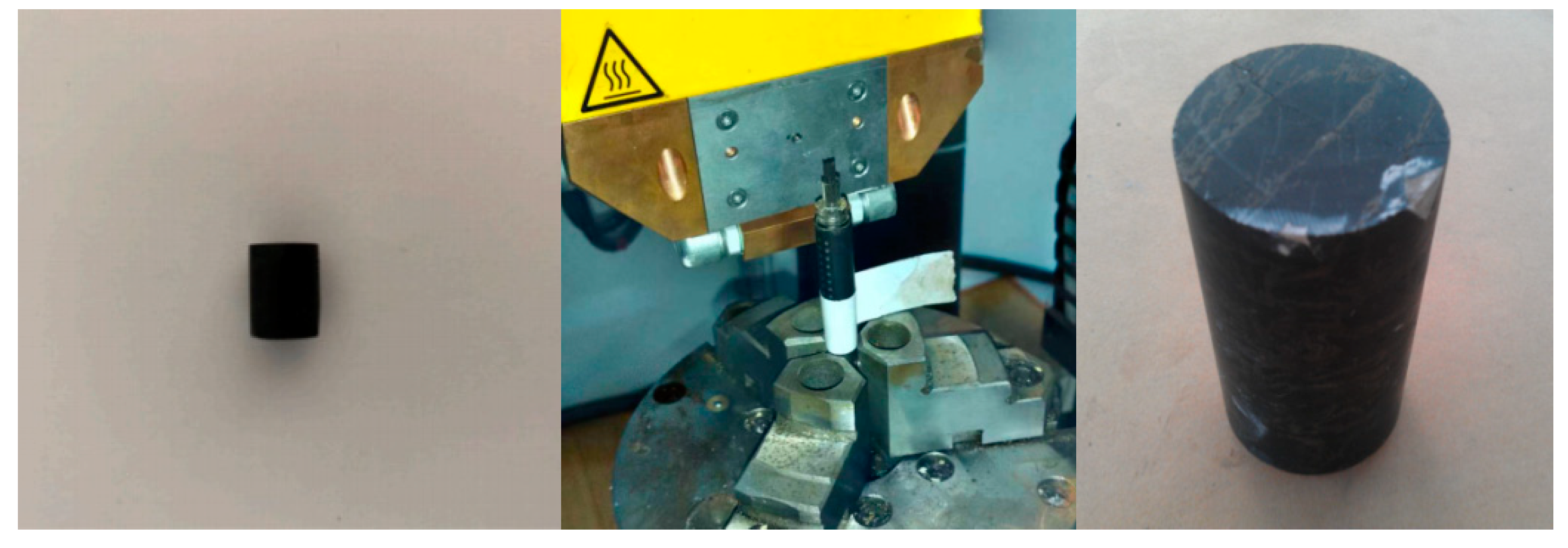
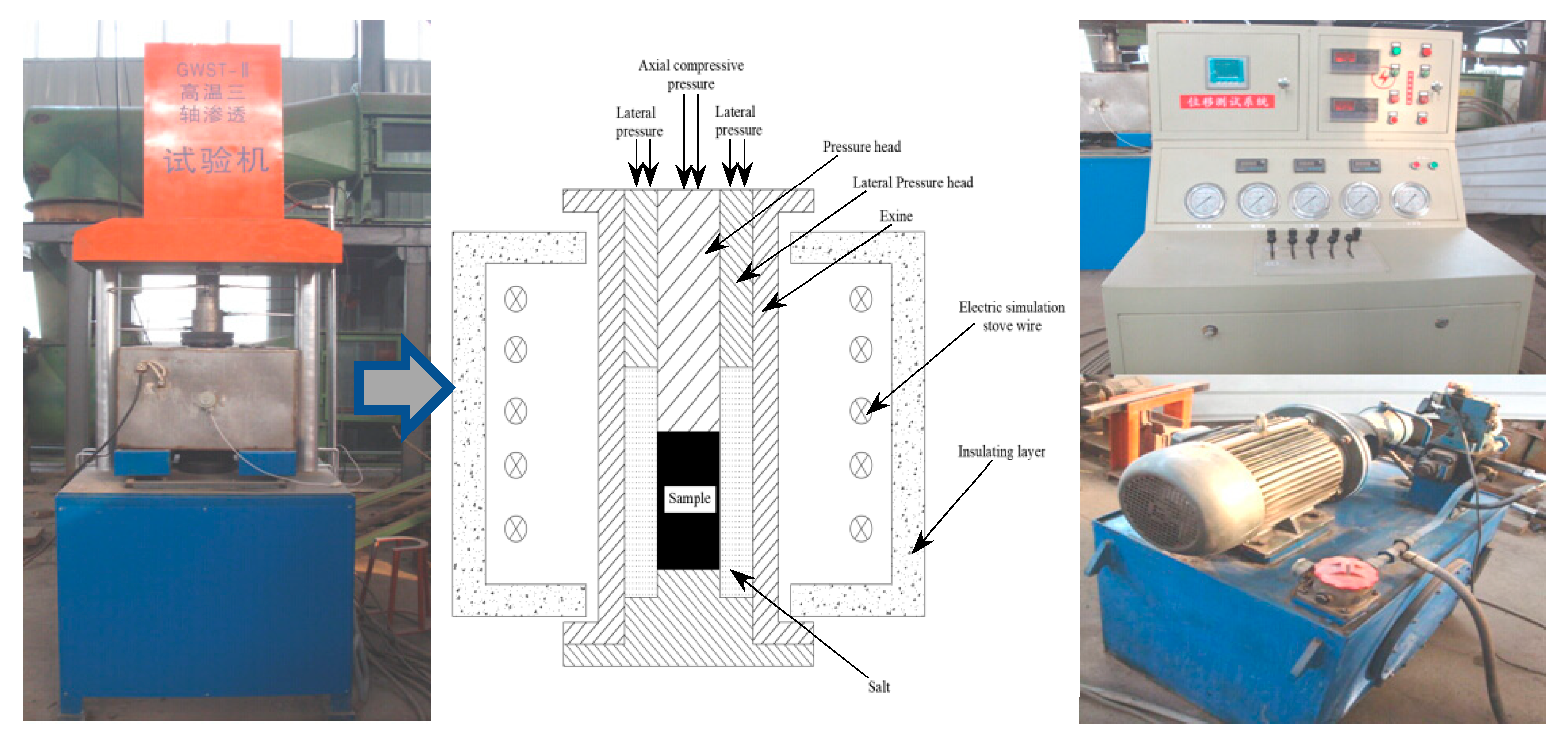

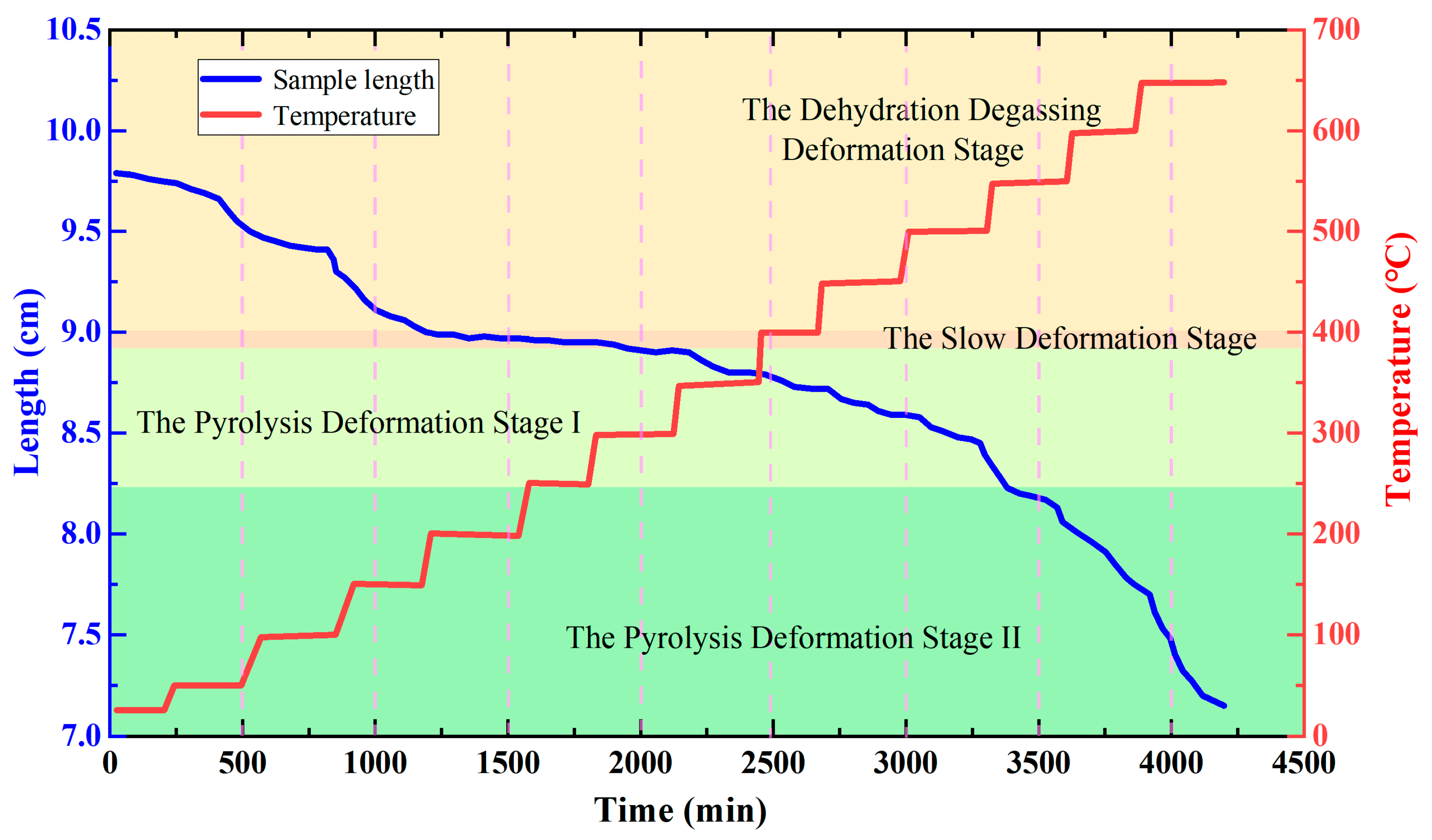

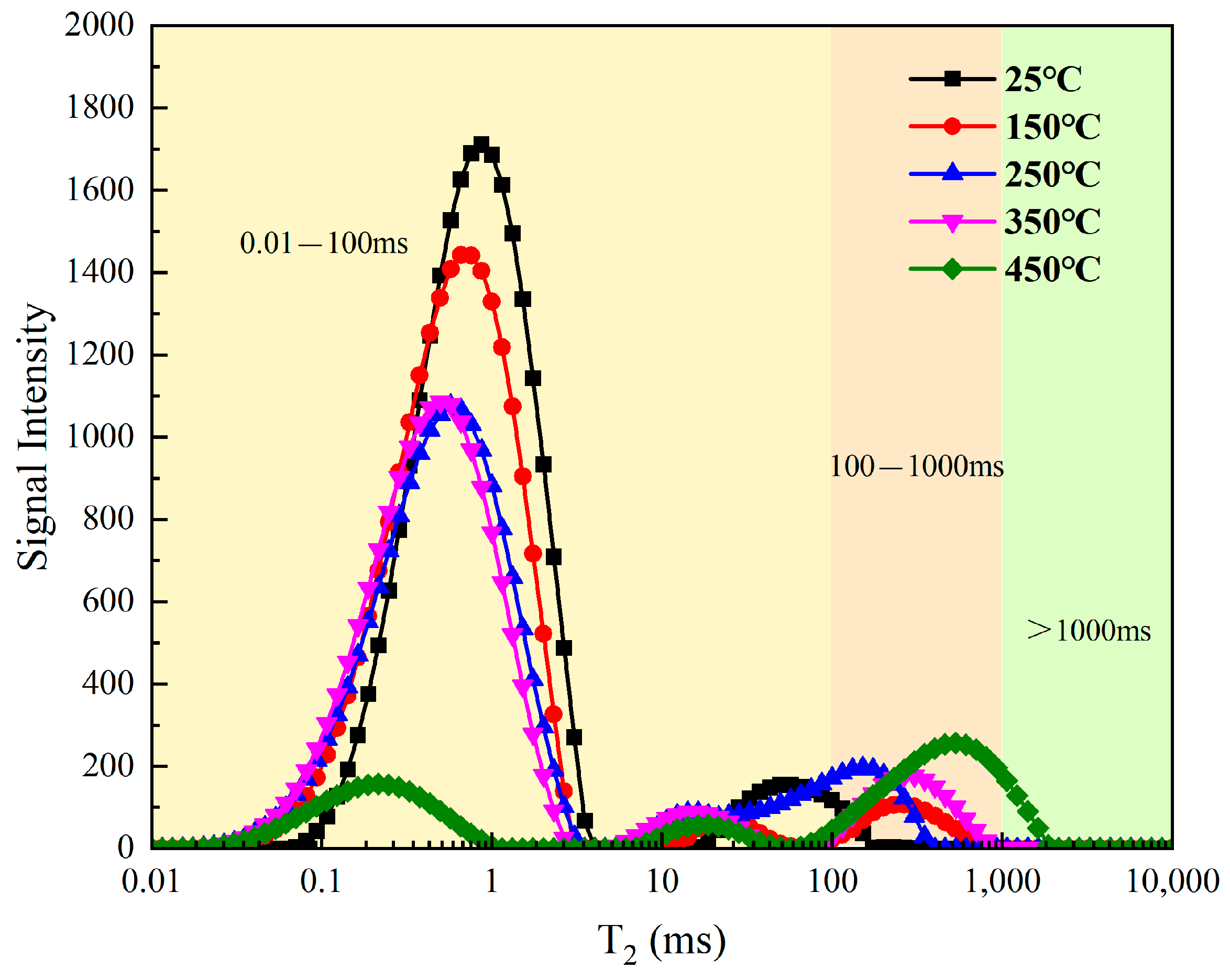
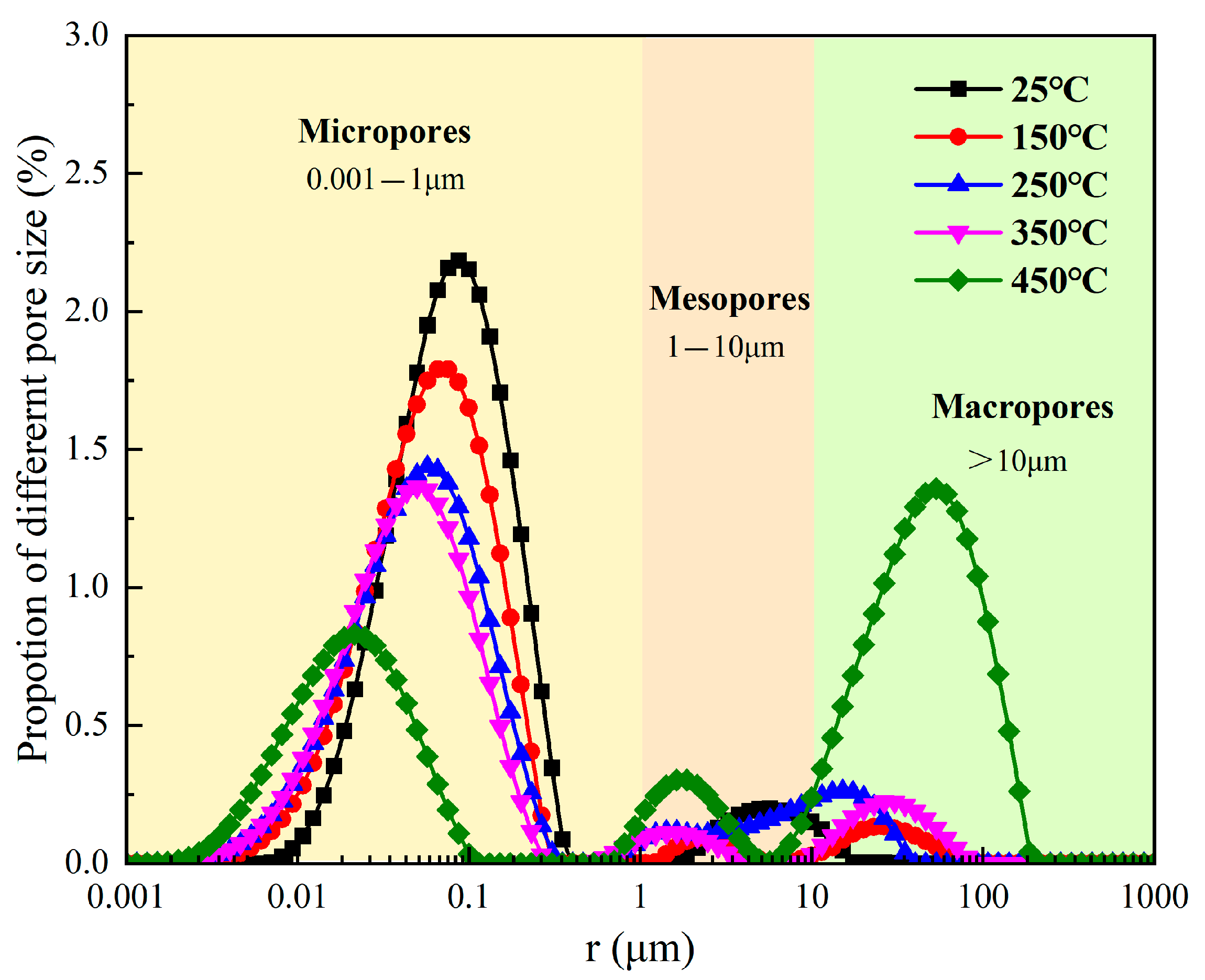
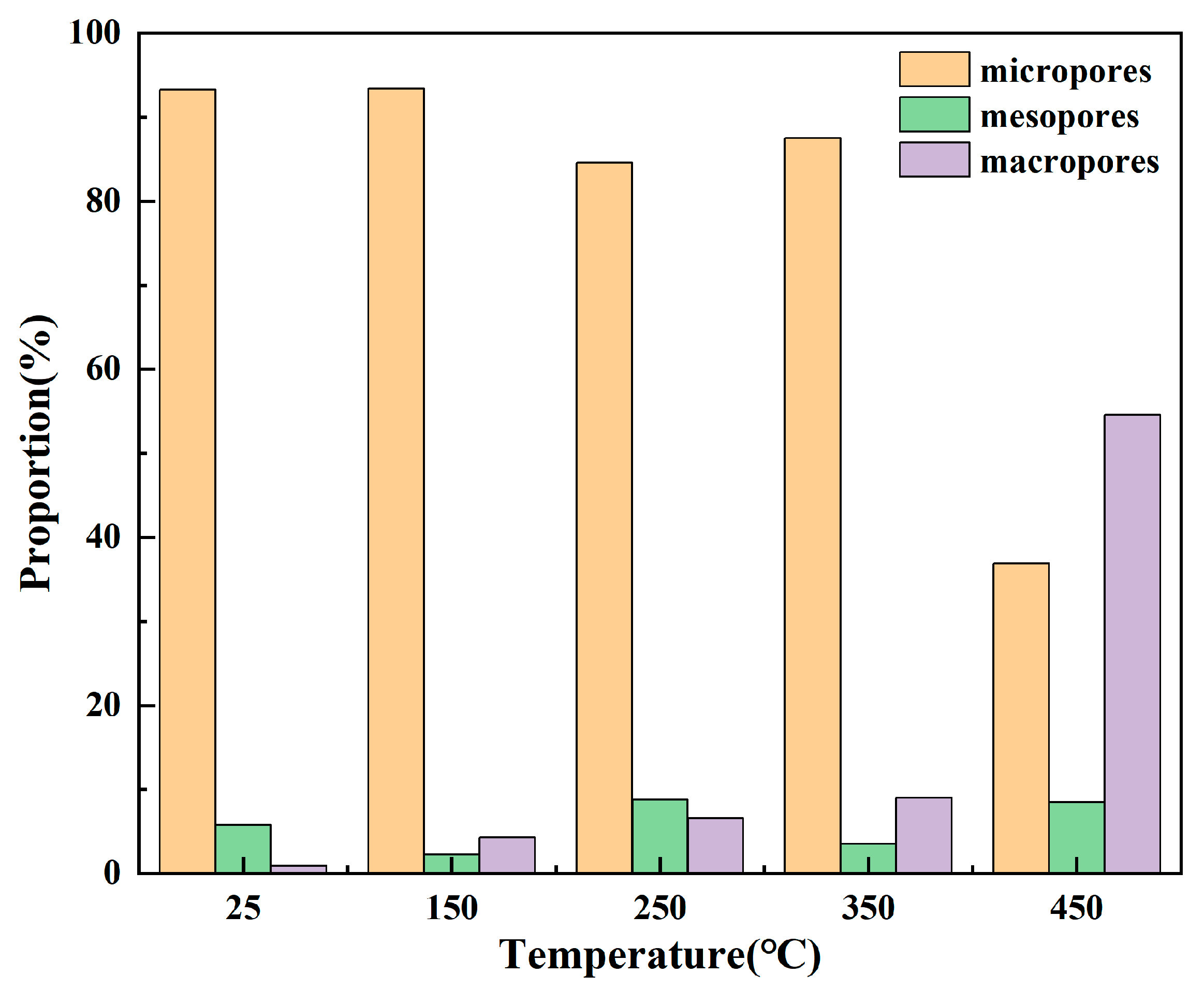

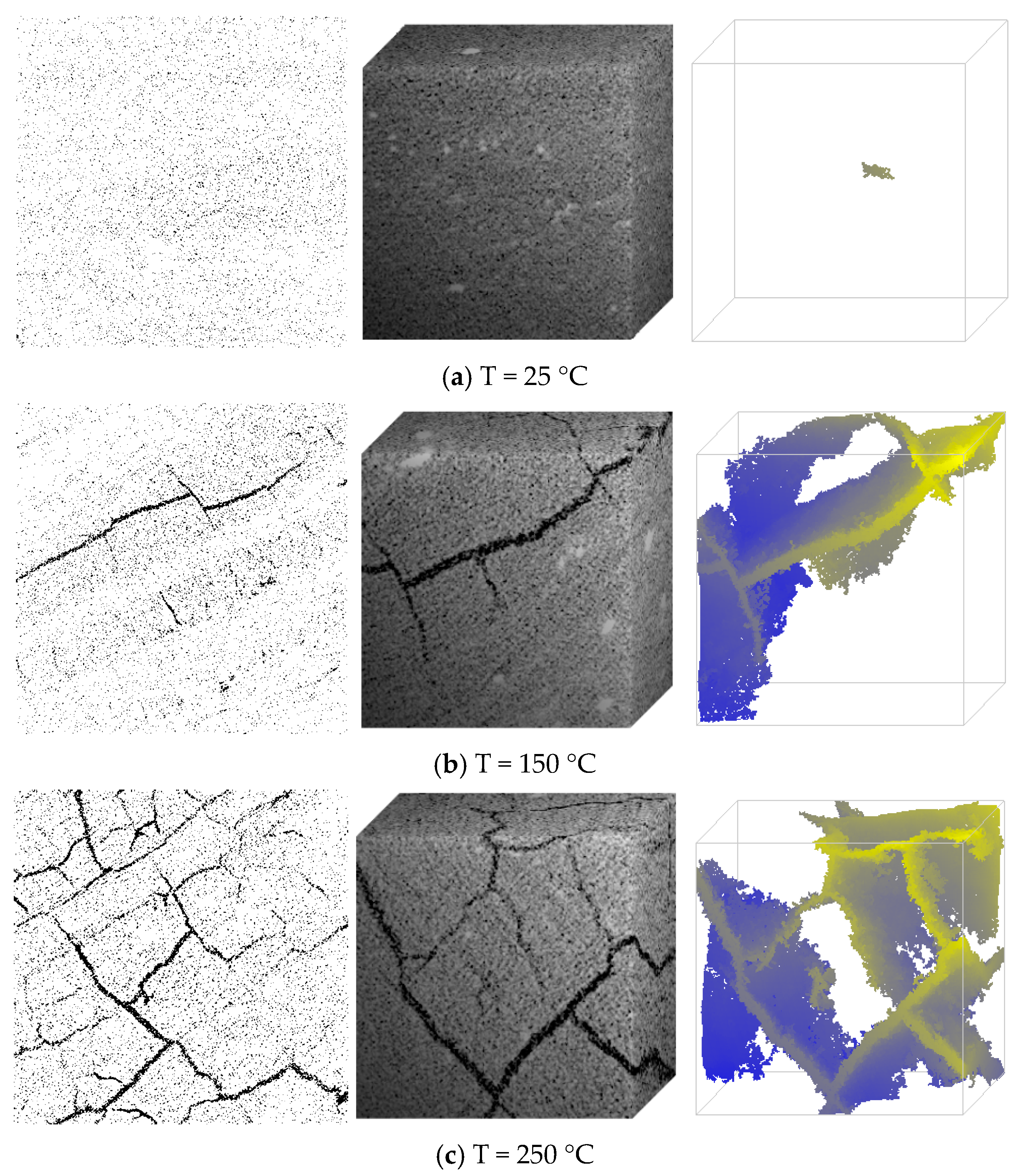
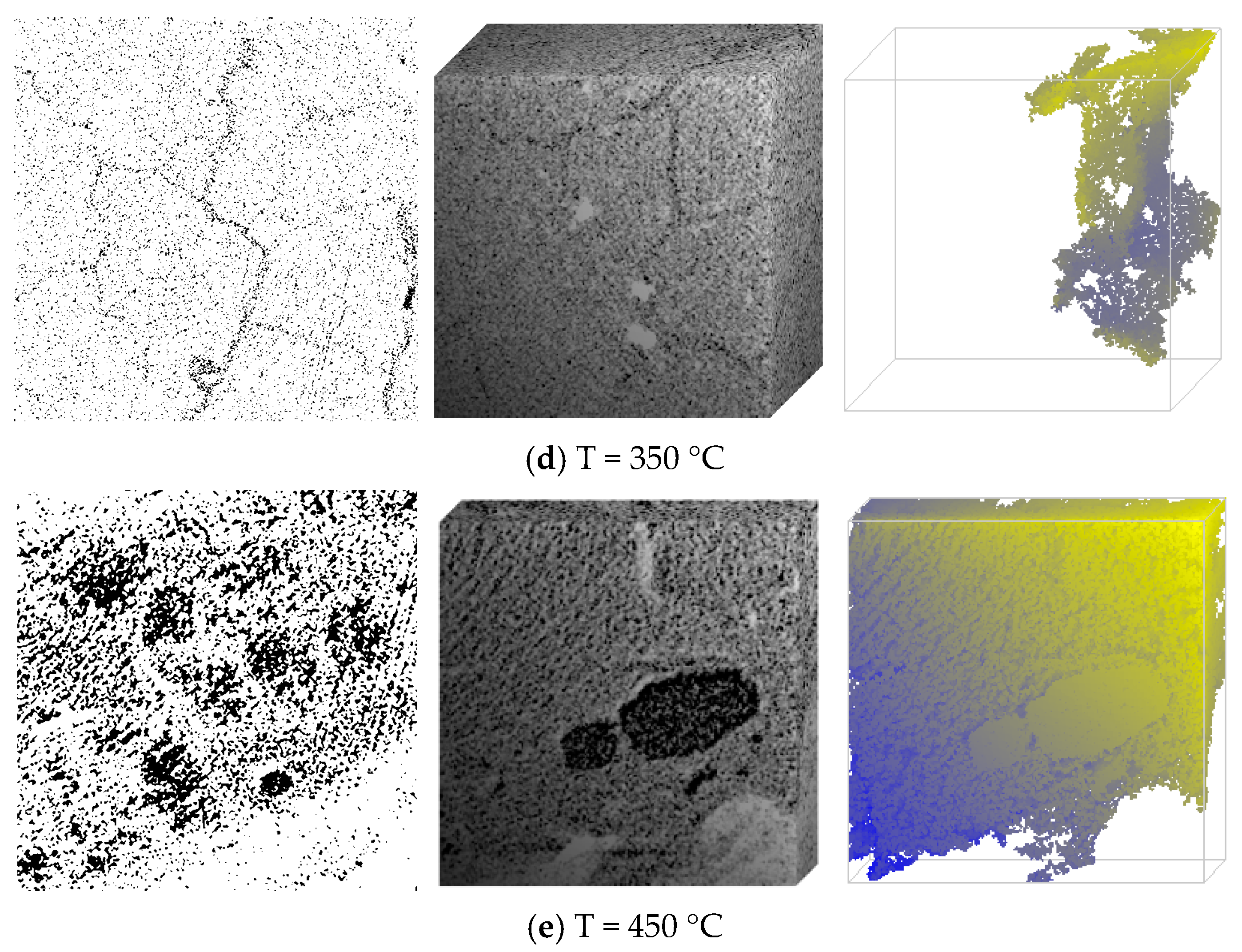
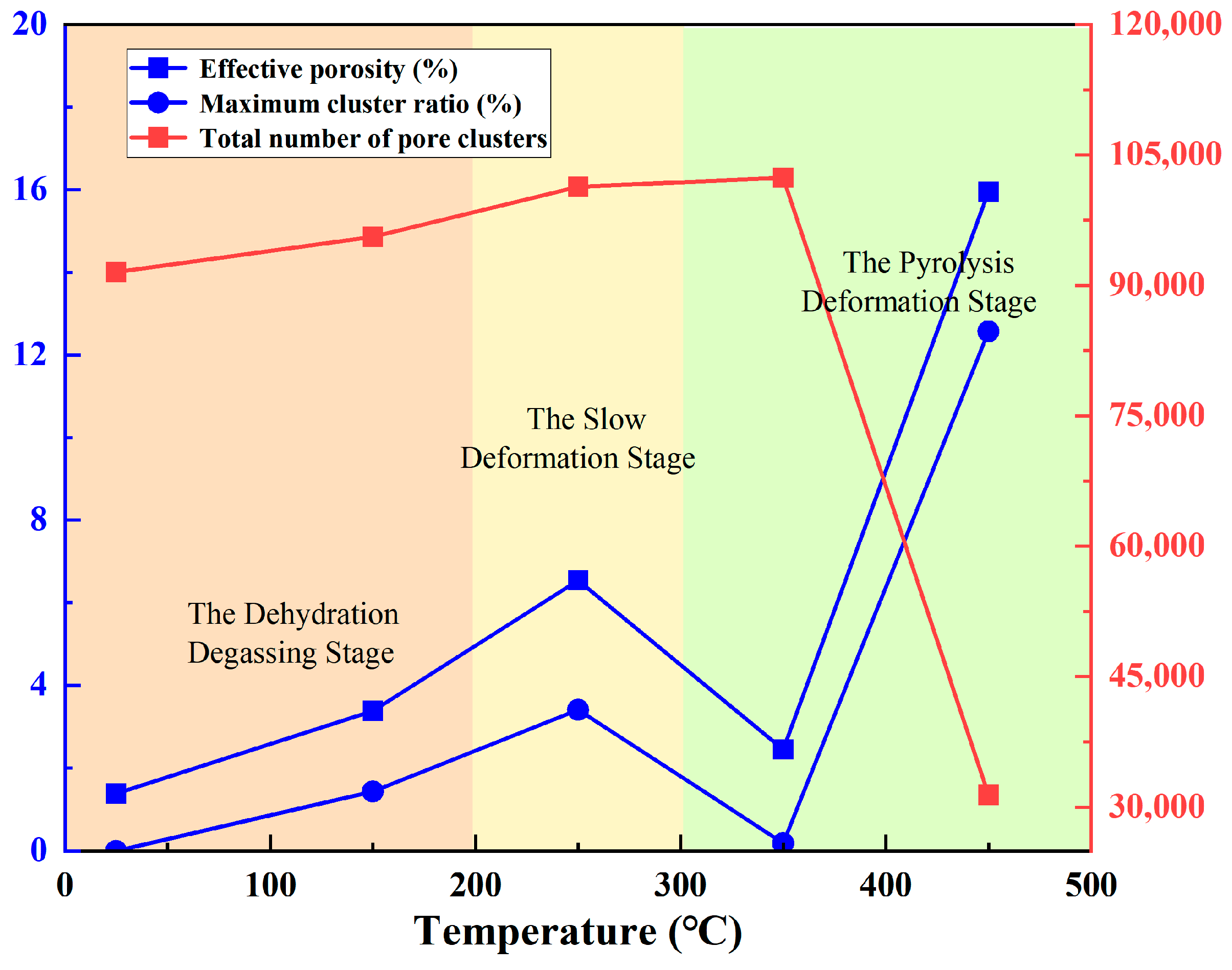

| Items | Proximate Analysis (wt%) | Ultimate Analysis (in daf. Basis, wt%) | ||||||
|---|---|---|---|---|---|---|---|---|
| Mad | Ad | Vdaf | C | H | O | N | S | |
| lignite | 18.56 | 9.17 | 54.6 | 67.44 | 4.48 | 1.04 | 0.81 | 26.23 |
| Temperature (°C) | Effective Porosity (%) | Free Liquid Porosity (%) | Permeability (md) |
|---|---|---|---|
| 25 | 8.73 | 2.18 | 1.37 |
| 150 | 16.94 | 1.89 | 5.38 |
| 250 | 23.82 | 4.27 | 29.80 |
| 350 | 23.07 | 3.23 | 13.08 |
| 450 | 30.22 | 13.01 | 856.99 |
| Temperature (°C) | Effective Porosity (%) | Maximum Cluster Ratio (%) | Total Number of Pore Clusters |
|---|---|---|---|
| 25 | 1.38 | 0 | 91,538 |
| 150 | 3.38 | 1.43 | 95,590 |
| 250 | 6.54 | 3.41 | 101,333 |
| 350 | 2.45 | 0.185 | 102,377 |
| 450 | 15.95 | 12.57 | 31,394 |
Disclaimer/Publisher’s Note: The statements, opinions and data contained in all publications are solely those of the individual author(s) and contributor(s) and not of MDPI and/or the editor(s). MDPI and/or the editor(s) disclaim responsibility for any injury to people or property resulting from any ideas, methods, instructions or products referred to in the content. |
© 2025 by the authors. Licensee MDPI, Basel, Switzerland. This article is an open access article distributed under the terms and conditions of the Creative Commons Attribution (CC BY) license (https://creativecommons.org/licenses/by/4.0/).
Share and Cite
Zhang, F.; Niu, S.; He, J.; Zhang, K.; Qin, Z. Deformation and Pore Structure Characteristics of Lignite Pyrolysis with Temperature Under Triaxial Stress. Processes 2025, 13, 1444. https://doi.org/10.3390/pr13051444
Zhang F, Niu S, He J, Zhang K, Qin Z. Deformation and Pore Structure Characteristics of Lignite Pyrolysis with Temperature Under Triaxial Stress. Processes. 2025; 13(5):1444. https://doi.org/10.3390/pr13051444
Chicago/Turabian StyleZhang, Feng, Shiwei Niu, Jiawei He, Kai Zhang, and Zhongcheng Qin. 2025. "Deformation and Pore Structure Characteristics of Lignite Pyrolysis with Temperature Under Triaxial Stress" Processes 13, no. 5: 1444. https://doi.org/10.3390/pr13051444
APA StyleZhang, F., Niu, S., He, J., Zhang, K., & Qin, Z. (2025). Deformation and Pore Structure Characteristics of Lignite Pyrolysis with Temperature Under Triaxial Stress. Processes, 13(5), 1444. https://doi.org/10.3390/pr13051444






